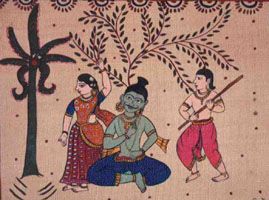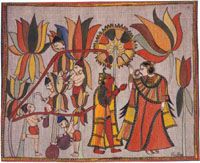The Tradition of Paintings
India goes back to prehistoric times when early man started painting on walls of caves where he lived. Since hunting was the prime occupation of these people wall paintings on rugged walls of rocks have an abundance of animal figures, hunting scenes and celebration dances.In course of time art of painting became a mirror of thought, religion, philosophy, cult and culture of people. It conveyed to the viewer how man has lived over time, his feelings, thoughts on divine powers and mode of worship. Art has been associated with religion and worship from the earliest times.
 |
Home Art
Folk Art
Traditional Art
Classical Art |
 |
Ancient India's religious art differs strikingly from religious literature. The latter is the work of man with vocations, brahmins, monks and ascetics. The former came chiefly from the hands of secular craftsmen, who worked according to instructions of the priests and increasingly rigid iconographical rules. The craftsmen loved their work that is seen in the religious forms they created.
Literary references alone would prove that painting was a highly developed art in ancient India. Apart from professionals many amateur artists could ably handle a brush. Literature shows that kings dwelt in grand palaces that were decorated with lovely wall paintings and sculpture. Most of these have now vanished. Those that have survived are now in a very bad condition But these are sufficient to express the high level of artists' work. They are mostly found as murals in cave temples. A few caves contain rough sketches mostly in primitive style. But they give us a clue\sample of the work of highly developed schools and are among the greatest surviving paintings of any ancient civilisation.





